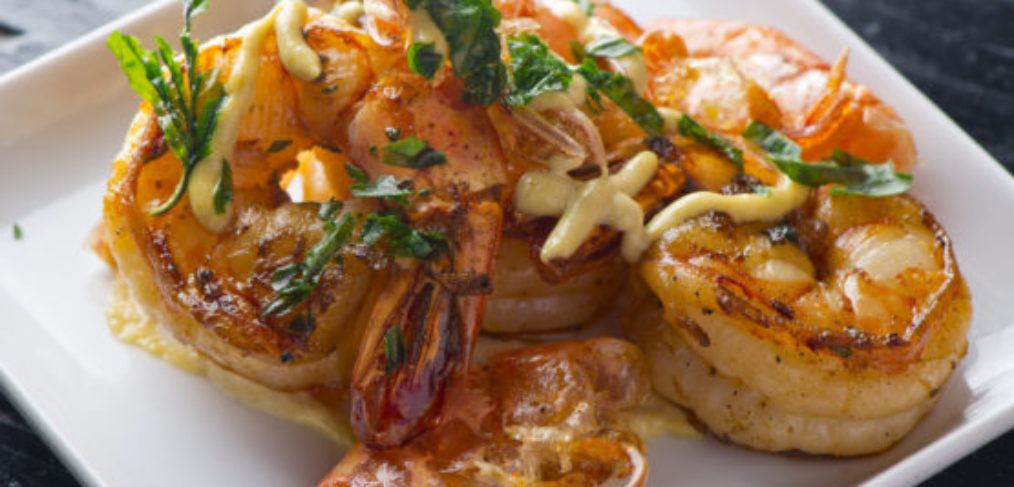Love Shrimp? Here’s What You Need to Know about Sourcing.

Shrimp Scampi.
The butter. The garlic. The lemon. The hint of parsley.
Since I was a little girl, my earliest dining out memories feature me ordering shrimp scampi. It was an absolute delicacy. We did not dine out with any regularity, but on the rare occasion that we did, that was my go to.
Growing up, I continued to regard eating shrimp as something special.
Even when I was beginning to go down the vegan route, it was one of the last things I gave up.
Turns out, it’s not just me; shrimp is a national obsession and consumption has been escalating, up to about 4.4 pounds per person per year, a marked increase from 4 pounds per person just five years ago. It seems we will eat as much shrimp as we can get our hands on — over 1.5 billion pounds per year (1).
Back then, however, I had not a clue that I might be curious to ask where it came from.
I’m fairly confident now that it wasn’t exactly local (I grew up in New York) and very likely, it was also not wild or sustainable.
90% of the shrimp we eat in the United States is imported (2), most of it coming from Southeast Asian countries like Indonesia, India, Thailand and Vietnam, where environmentally destructive practices and slave labor are common.
What’s more, most of what is available to us in the US is farmed, not wild caught (3).
Farmed shrimp is highly correlated with:
- Mangrove destruction (4); a fifth of mangroves worldwide have been lost since 1980, mostly because of clearance to make way for the farms which often get choked with waste, antibiotics and fertilizers.
- Antibiotic overuse, contributing to, for one thing, antibiotic-resistant MRSA on the shrimp (5) and for another, spillage into the water systems
- Slave Labor; a six-month investigation by The Guardian (6) “established that large numbers of men bought and sold like animals and held against their will on fishing boats off Thailand are integral to the production of prawns (commonly called shrimp in the US) sold in leading supermarkets around the world, including the top four global retailers: Walmart, Carrefour, Costco and Tesco.”
So does that mean saying goodbye permanently to consuming shrimp?
Not necessarily.
Source properly:
According to FoodPrint (7), when it comes to buying shrimp, Monterey Bay’s Seafood Watch (8) ranking system is the most reliable tool available, perhaps more so than the Marine Stewardship Council, owned by Unilever.
The recommendation is to always keep local and avoid anything imported.
In addition, if shrimp is something that’s become a common protein source for you, consider making it something you eat less frequently.
Finally, be flexible and open to changing the recipe you’re planing to make with something more sustainable based on where you live.
This is not to say that a local, pasture raised chicken thigh is going to be mistaken for shrimp in a scampi dish; but in the grand scheme of things, we can chose to take a far more mindful path by choosing something else.
For me, it’s about asking the questions, whether in a restaurant, grocery store or farmer’s market.
If the answers aren’t straightforward and immediate, that speaks volumes in itself, and is a good reason to make another choice.
Satisfying a craving for shrimp (or any other food that might not be the best choice, all things considered) versus making a more conscious choice is one means of making each of our voices heard.
Now you know!
(1) https://www.nytimes.com/2019/10/15/dining/shrimp-sourcing-united-states.html
(2) https://www.seafoodwatch.org/recommendations/search?query=%3Aspecies%3BShrimp
(3) https://foodprint.org/blog/wild-and-farmed-shrimp/
(4) https://www.reuters.com/article/us-mangroves/mangroves-under-threat-from-shrimp-farms-u-n-idUSBRE8AD1EG20121114
(5) https://www.consumerreports.org/cro/magazine/2015/06/shrimp-safety/index.htm
(6) https://www.theguardian.com/global-development/2014/jun/10/supermarket-prawns-thailand-produced-slave-labour
(7) https://www.foodprint.org
(8) https://www.seafoodwatch.org





